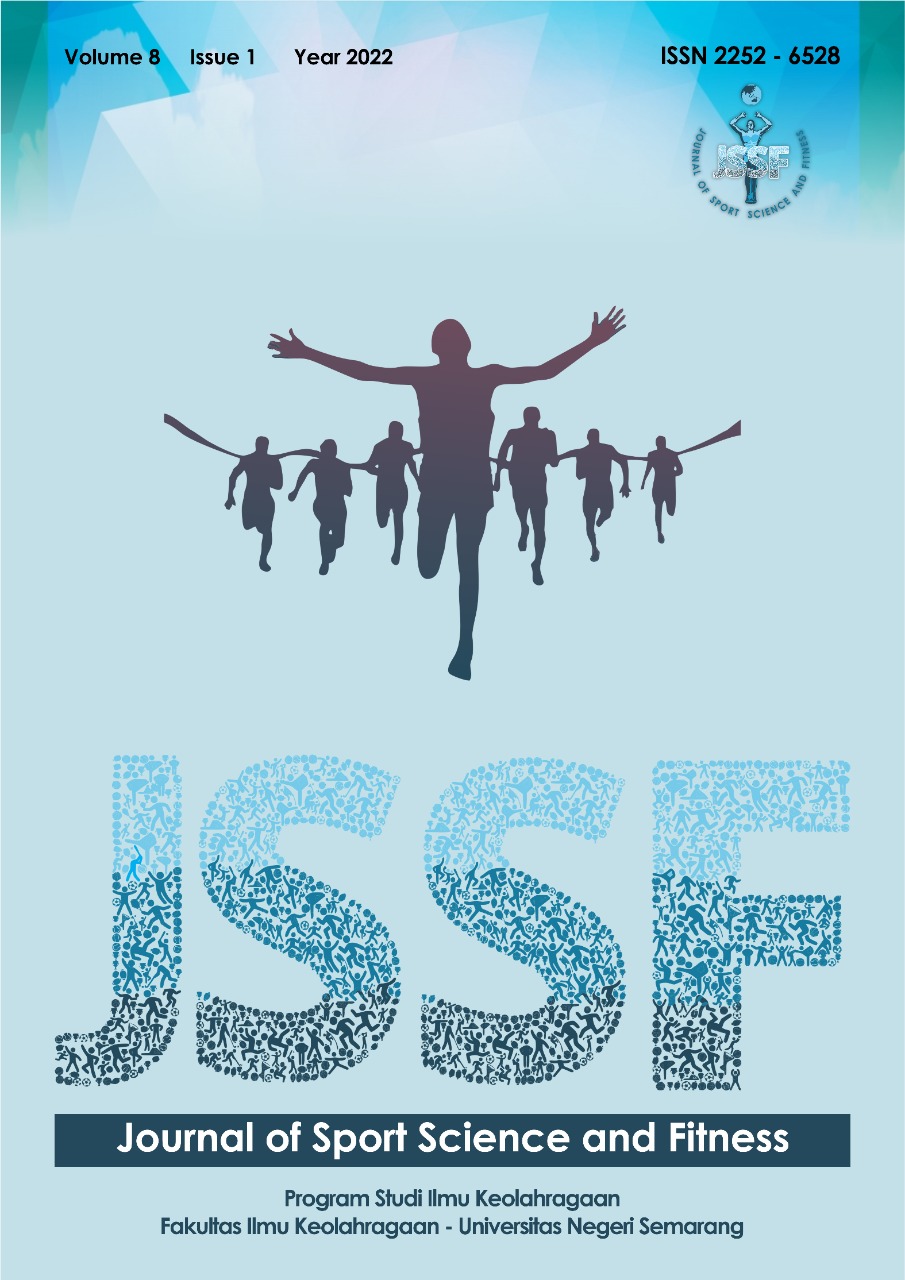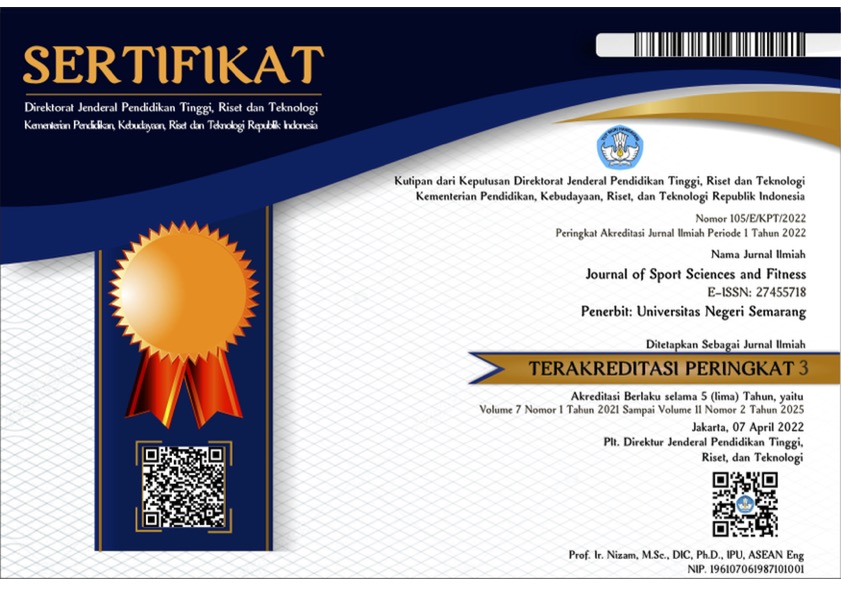PERBEDAAN TINGKAT DISMENORE ANTARA PESERTA SENAM AEROBIK RUTIN DAN TIDAK RUTIN PADA WANITA
Abstract
Abstrak
Tujuan penelitian untuk mengetahui perbedaan tingkat dismenorea antara peserta senam aerobik rutin dan tidak rutin pada wanita. Metode penelitian menggunakan pendekatan kuantitatif dengan jenis penelitian cross sectional survey. Populasi se-Kecamatan Gunungpati, sampel diambil dari 4 klub senam dan memperoleh 61 wanita yang terdiri dari 24 peserta senam aerobik rutin dan 37 peserta senam aerobik tidak rutin. Teknik penarikan sampel menggunakan purposive sampling dengan kriteria tertentu. Untuk membedakan peserta senam aerobik rutin dan tidak rutin, sampel mengisi lembar kuesioner. Selanjutnya sampel mengisi lembar skor NRS (Numeric Rating Scale). Analisis data dalam penelitian ini menggunakan bantuan program SPSS versi 25. Hasil uji normalitas data peserta senam aerobik tidak rutin memiliki nilai p=0,013>0,05 berdistribusi tidak normal sedangkan data peserta senam aerobik rutin memiliki nilai p=0,000<0,05 berdistribusi tidak normal. Sehingga penelitian menggunakan uji Mann Whitney. Hasil penelitian ini adalah rata-rata tingkat dismenorea peserta senam aerobik rutin 1,31+1,82 (n=24), peserta senam aerobik tidak rutin 3,58+2,45 (n=37), p=0,000. Simpulan penelitian ini adalah adanya perbedaan tingkat dismenorea antara peserta senam aerobik rutin dan tidak rutin pada wanita. Tingkat dismenore peserta senam aerobik rutin lebih rendah dari tingkat dismenore peserta senam aerobik tidak rutin. Saran yang diberikan kepada peserta senam aerobik untuk meningkatkan pola hidup sehat dengan senam aerobik lebih rutin.
Abstract
The purpose of this study was to determine differences in the level of dysmenorrhea between participants in routine and non-routine aerobic exercise in women. The research method uses a quantitative approach with a cross-sectional survey type of research. In the population in Gunungpati District, samples were taken from 4 aerobic clubs and obtained 61 women consisting of 24 participants in routine aerobic exercise and 37 participants in non-routine aerobic exercise. The sampling technique used purposive sampling with certain criteria. To distinguish participants from routine and non-routine aerobic exercise, the sample filled out a questionnaire sheet. Then the sample filled out the NRS (Numeric Rating Scale) score sheet. Data analysis in this study used the SPSS version 25 program. The results of the normality test for non-routine aerobic exercise participants had a p-value of 0.013> 0.05 with a normal distribution abnormal, while the data of regular aerobic exercise participants had a p-value of 0.000 <0.05 with a normal distribution. abnormal. So the study used the Mann-Whitney test. The results of this study were the average level of dysmenorrhoea in regular aerobic exercise participants was 1.31+1.82 (n=24), non-routine aerobic exercise participants were 3.58+2.45 (n=37), p=0.000. The conclusion of this study is that there is a difference in the level of dysmenorrhea between participants in routine and non-routine aerobic exercise in women. The dysmenorrhea level of the participants of routine aerobic exercise was lower than the level of dysmenorrhea of the participants of non-routine aerobic exercise. Advice is given to aerobic exercise participants to improve a healthy lifestyle with more regular aerobic exercise
References
Bare, B. G. & Smeltzer, S. C. (2002). Ajar Keperawatan Medikal Bedah Brunner & Suddarth (8th ed.).
Cahyaningtias, P. L., & Wahyuliati, T. (2016). Pengaruh Olahraga Terhadap Derajat Nyeri Dismenorea pada Wanita Belum Menikah. Mutiara Medika: Jurnal Kedokteran Dan Kesehatan, 7(2 (s)), 120–126.
Darsi, H. (2018). Pengaruh Senam Aerobic Low Impact terhadap Peningkatan VO2MAX. Jurnal Pendidikan Jasmani Dan Olahraga, 1, 42–51.
Dehnavi, Z. M., Jafarnejad, F., & Kamali, Z. (2018). The Effect of aerobic exercise on primary dysmenorrhea: A clinical trial study.Journal of Education and Health Promotion. Vol 7(3)
Fajarwati, F. (2017). Pengaruh Senam Aerobik Low Impact Terhadap Dismenore Primer Pada Remaja As Salafiyyah Mlangi. Kebidanan 'Aisyiyah Yogyakarta
Fajriati, N. L. (2019). Pengaruh Senam Aerobik terhadap Derajat Dismenorea pada Remaja Umur 15-17 Tahun di SMA Negeri 12 Semarang. Ilmu Keolahragaan Unnes
Halimah, I,. (2015). Perbedaan Tingkat Dismenore pada Aktifitas Ringan, Sedang, dan Berat Atlet Wanita KBB. Ilmu Keolahragaan UPI
Hastuti, W., & Widiyaningsih, W. (2020). Senam Aerobic Untuk Mengatasi Nyeri Menstruasi Pada Remaja Putri Di Pondok Pesantren Al Ishlah Semarang. Jurnal Kesehatan Kusuma Husada, 86–90.
Hikmah, E. (2015). Pengaruh Senam Aerobik terhadap Kejadian Premenstrual Syndrome (PMS) pada Mahasiswi Jurusan Keperawatan Tangerang. Jurnal Medikes, 2(November 2015), 123–132.
Jia, L., & Li, L. (2020). Research on core strength training of aerobics based on artificial intelligence and sensor network. Eurasip Journal on Wireless Communications and Networking, 2020(1).
Khan, N. Z. (2019). Wanita dan Hormon (M. Utami & D. Prabantini (eds.)). Rapha Publisher.
Krastanaya, I. (2015). Hubungan Frekuensi dan Intensitas Senam Aerobik dengan Derajat Dismenore pada Peserta Senam Aerobik di Kota Pontianak. Universitas Tanjungpura Pontianak.
Kumalasari, M. L. F. (2017). The Effectiviness of Dysmenorrhea Gymnastics as an Alternative Therapy in Reducing Menstrual Pain. Journal of Health Science and Prevention, 1(1), 10–14.
Larasati, T. A., A., & Alatas, F. (2016). Dismenore Primer dan Faktor Risiko Dismenore Primer pada Remaja. Majority, 5(3), 79–84.
Lestari, N. M. S. D. (2013). Pengaruh dismenorea pada remaja. Seminar Nasional FMIPA UNDIKSHA III, 323–329.
Marlinda, R. (2013). Pengaruh Senam Dismenore terhadap Penurunan Dismenore pada Remaja Putri di Desa Sidoharjo Kecamatan Pati. Jurnal Keperawatan Maternitas, 1(2), 118–123.
Mashnafi, S., Plat, J., Mensink, R. P., Joris, P. J., Kleinloog, J. P. D., & Baumgartner, S. (2021). Effects of an 8-week aerobic exercise program on plasma markers for cholesterol absorption and synthesis in older overweight and obese men. Lipids in Health and Disease, 20(1), 1–8.
Muqorobin, A. (2019). Pengaruh Senam Aerobik dengan Pemberian Jus Nanas (ananas comosus) terhadap Penurunan Nyeri Dismenor Tipe 1 pada Remaja. Ilmu Keolahragaan Unnes.
Muqsithoh, M. A. H. (2016). Aktualisasi Diri Remaja yang Menikah Dini di Desa Sidoagung, Kabupaten Kebumen. Psikologi Unnes.
Octaviani, D. A. (2019). Pengaruh Pemberian Aromaterapi Jeruk (Orange) Terhadap Skor Nyeri Dismenore Pada Remaja Di Semarang. Jurnal Kesehatan STIKES Telogorejo, 9(2), 35–41.
Pertiwi, M. R., Wahid, A., & Marlinda, E. (2015). Senam Aerobik Low Impact terhadap dismneore Primer pada Remaja Putri di SMKN 1 Martapura. Dunia Keperawatan, 3(2), 46–52.
Rakhma, A. (2012). Gambaran Derajat Dismenore dan Upaya Penanganannya pada Siswi Sekolah Menengah Kejuruan Arjuna Depok Jawa Barat. Ilmu Keperawatan UIN Syarif Hidayatullah Jakarta 66, 37–39.
Rustam, E. (2015). Gambaran Pengetahuan Remaja Puteri Terhadap Nyeri Haid (Dismenore) dan Cara Penanggulangannya. Jurnal Kesehatan Andalas, 4(1), 286–290.
Samy, A., Zaki, S. S., Metwally, A. A., Mahmoud, D. S. E., Elzahaby, I. M., Amin, A. H., Eissa, A. I., Abbas, A. M., Hussein, A. H., Talaat, B., & Ali, A. S. (2019). The Effect of Zumba Exercise on Reducing Menstrual Pain in Young Women with Primary Dysmenorrhea: A Randomized Controlled Trial. Journal of Pediatric and Adolescent Gynecology, 32(5), 541–545.
Setiawati, S. E. (2015). Pengaruh Stres Terhadap Siklus Menstruasi pada Remaja. Journal Majority, 4(1), 94–98.
Sugiyono. (2018). Metode Penelitian Kuantitatif, Kualitatif, dan R&D (Sutopo (ed.)). ALFABETA.








